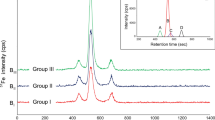Abstract
The present research is aimed to characterize the potential efficiency of two chelators after chromium(VI) administration for 60 days following two doses of 15 and 30 mg/kg chromium(VI) per body weight daily to male rats. However, the hypothesis that the two chelators might be more efficient as combined therapy than as single therapy in removing chromium(VI) from rat organs was considered. In this way, two known chelators deferasirox and deferiprone were chosen and given orally as a single or combined therapy for a period of 1 week. Chromium(VI) and iron concentrations in tissues were determined by flame atomic absorption spectroscopy. The combined chelation therapy results show that deferasirox and deferiprone are able to remove chromium(VI) ions from various tissues while iron concentration returned to normal levels and symptoms also decreased.

Similar content being viewed by others
References
Agency for Toxic Substances and Diseases Registry (ATSDR) (1998) Toxicological profile for chromium. Public Health Service. US Department of Health and Human Services, Atlanta
Amiri A, Fatemi SJ, Fatemi SN (2007) Removal of thallium by combining desferrioxamine and deferiprone chelators in rats. Biometals 20:159–163
Bagchi D, Stohs SJ, Downs BW, Bagchi M, Preuss HG (2002) Cytotoxicity and oxidative mechanisms of different forms of chromium. Toxicology 180:5–22
Cappellini MD (2008) Long-term efficacy and safety of deferasirox. Blood Rev 2:35–41
Clarke ET, Martell AE (1992) Stabilities of 1, 2-dimethyl-3-hydroxypyrid-4-one chelates of divalent and trivalent metal ions. Inorg Chim Acta 19:57–63
Codd R, Dillon CT, Levina A, Lay PA (2001) Studies on the genotoxicity of chromium: from the test tube to the cell. Coord Chem Rev 216–217:537–582
Evans RW, Kong X, Hider RC (2012) Iron mobilization from transferrin by therapeutic iron chelating agents. Biochim Biophys Acta 1820:282–290
Fatemi SJ, Amiri A, Bazargan MH, Tubafard S, Fatemi SN (2007) Clinical evaluation of desferrioxamine (DFO) for removal of thallium ions in rats. Int J Artif Organs 30:902–905
Fatemi SJ, Tubafard S, Nadi B (2009) Evaluation of the effect of cadmium on rat organs and investigation of diethyl carbamate as an oral drug in treatment of cadmium toxicity. Med Chem Res 18:179–186
Flora SJS, Bhattacharyan R, Vijayaraghavan R (1995) Combined therapeutic potential of meso dimercaptosuccinic acid and calcium edentate on the mobilization and distribution of lead in experimental lead intoxication in rats. Fundam Appl Toxicol 25:233–240
Galanello R, Agus A, Campus S, Danjou F, Giardina PJ, Grady RW (2010) Combined iron chelation therapy. Ann N Y Acad Sci 1202:79–86
Glickstein H, BenEl R, Link G, Breuer W, Konijn AM, Hershko C, Nick H, Cabantchik ZI (2006) Action of chelators in iron-loaded cardiac cells: accessibility to intracellular labile iron and functional consequences. Blood 108:3195–3203
Gomez W, Esparza JL, Domingo JL, Singha PK, Jones MM (1988) Comparative aluminium mobilizing action of desferrioxamine and four 3-hydroxypyrid-4-ones in aluminium-loaded rats. Toxicology 130:175–181
Gyparaki M, Porter JB, Hirani S, Streater M, Hider RC, Huehns ER (1987) In vivo evaluation of hydroxypyridone iron chelators in a mouse model. Acta Haematol 78:217–221
Heinz U, Hegetschweiler K, Acklin P, Faller B, Lattmann R, Schnebli HP (1999) 4-[3,5-Bis (2-hydroxyphenyl)-1,2,4-triazol-1-yl]-benzoic acid: a novel, efficient and selective iron (iii) complexing agent. Angew Chem Int Edit 38:2568–2571
Hershko C, Konijn AM, Nick HP, Breuer W, Cabantchik ZI, Link G (2001) ICL670A: a new synthetic oral chelator: evaluation in hypertransfused rats with selective radioiron probes of hepatocellular and reticuloendothelial iron stores and in iron-loaded rat heart cells in culture. Blood 97:1115–1122
Hider RC, Kontoghiorghes G, Silver J (1984) Pharmaceutical compositions. GB patent 2118176 A
Kaur G, Srivastava UC, Dwivedi RS, Srivastava RC (1984) Influence of polyaminocarboxylic acids on the removal of manganese-54 from the body organs of sham-operated and partially hepatectomized rats. Toxicol Lett 22:1–6
Kimbrough DE, Cohen Y, Winer AM (1999) A critical assessment of chromium in the environment. Crit Rev Environ Sci Technol 29:1–46
Kontoghiorghes GJ, Aldouri MA, Hoffbrand AV, Barr J, Wonke B, Kourouclaris T, Sheppard L (1987) Effective chelation of iron in beta thalassaemia with the oral chelator 1,2-dimethyl-3-hydroxypyrid-4-one. Br Med J 295:1509–1512
Ma Y, Zhou T, Kong X, Hider RC (2012) Chelating agents for the treatment of systemic iron overload. Curr Med Chem 19:2816–2827
Neufeld EJ (2006) Oral chelators deferasirox and deferiprone for transfusional iron overload in thalassemia major: new data, new questions. Blood 107(9):3436–3441
Nisbet-Brown E, Olivieri NF, Giardina PJ, Grady RW, Neufeld EJ, Sechaud R (2003) Effectiveness and safety of ICL670 in iron-loaded patients with thalassaemia: a placebo-controlled, dose-escalation trial. Lancet 361:1597–1602
O’Brien TJ, Ceryak S, Patierno SR (2003) Complexities of chromium carcinogenesis: role of cellular response, repair and recovery mechanisms. Mutat Res 533:3–36
Shokooh Saljooghi A, Fatemi SJ (2010) Clinical evaluation of deferasirox for removal of cadmium ions in rat. Biometals 23:707–712
Steinhauser S, Heinz U, Bartholoma M, Weyhermu¨ller T, Nick H, Hegetschweiler K (2004) Complex formation of ICL670 and related ligands with Fe(III) and Fe(II). Eur J Inorg Chem 21:4177–4192
Tubafard S, Fatemi SJ (2008) Chelation of bismuth by combining desferrioxamine and deferiprone in rats. Toxicol Ind Health 24:235–240
Voskaridou E, Christoulas D, Terpos E (2011) Successful chelation therapy with the combination of deferasirox and deferiprone in a patient with thalassaemia major and persisting severe iron overload after single-agent chelation therapies. Br J Haematol 154:654–656
Yang LPH, Keam SJ, Keating GM (2007) Deferasirox: a review of its use in the management of transfusional chronic iron overload. Drugs 67:2211–2230
Author information
Authors and Affiliations
Corresponding author
Rights and permissions
About this article
Cite this article
Iranmanesh, M., Fatemi, S.J.A., Ebrahimpour, R. et al. Chelation of chromium(VI) by combining deferasirox and deferiprone in rats. Biometals 26, 465–471 (2013). https://doi.org/10.1007/s10534-013-9631-5
Received:
Accepted:
Published:
Issue Date:
DOI: https://doi.org/10.1007/s10534-013-9631-5



